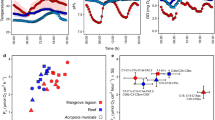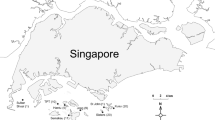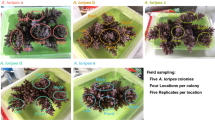Abstract
Coral-associated bacteria play critical roles in the regulation of coral health and function. Environmental perturbations that alter the bacterial community structure can render the coral holobiont more susceptible and less resilient to disease. Understanding the natural variation of the coral microbiome across space and host species provides a baseline that can be used to distinguish shifts in community structure. Using a 16S rRNA gene metabarcoding approach, this study examines bacterial community structure across three scleractinian coral hosts. Our results show that corals of three regions—eastern and western Peninsular Malaysia and Singapore—host distinct bacterial communities; despite these differences, we were able to identify a core microbiome shared across all three species. This core microbiome was also present in samples previously collected in Thailand, suggesting that these core microbes play an important role in promoting and maintaining host health. For example, several have been identified as dimethylsulfoniopropionate (DMSP) metabolizers that have roles in sulfur cycling and the suppression of bacterial pathogens. Pachyseris speciosa has the most variable microbiome, followed by Porites lutea, with the composition of the Diploastrea heliopora microbiome the least variable throughout all locations. Microbial taxa associated with each region or site are likely shaped by local environmental conditions. Taken together, host identity is a major driver of differences in microbial community structure, while environmental heterogeneity shapes communities at finer scales.





Similar content being viewed by others
Data Availability
Raw sequences obtained in this study have been deposited in the National Center for Biotechnology Information under BioProject records PRJNA744620 (D. heliopora), PRJNA744626 (Pa. speciosa) and PRJNA744641 (Po. lutea).
Code Availability
Made available as a supplementary file.
References
Paoli C, Montefalcone M, Morri C, Vassallo P, Bianchi CN (2017) Ecosystem functions and services of the marine animal forests. In: Rossi S, Bramanti L, Gori A, Orejas C (eds) Marine Animal Forests. Springer, Cham, pp 1271–1312
Hughes T, Kerry J, Álvarez-Noriega M et al (2017) Global warming and recurrent mass bleaching of corals. Nature 543:373–377
Sweatman H, Delean S, Syms C (2011) Assessing loss of coral cover on Australia’s Great Barrier Reef over two decades, with implications for longer-term trends. Coral Reefs 30:521–531
Bourne DG, Morrow KM, Webster NS (2016) Insights into the coral microbiome: underpinning the health and resilience of reef ecosystems. Annu Rev Microbiol 70:317–340
Peixoto RS, Rosado PM, Leite DCA, Rosado AS, Bourne DG (2017) Beneficial microorganisms for corals (BMC): Proposed mechanisms for coral health and resilience. Front Microbiol 8:341
Rosenberg E, Koren O, Reshef L, Efrony R, Zilber-Rosenberg I (2007) The role of microorganisms in coral health, disease and evolution. Nat Rev Microbiol 5:355–362
Thompson JR, Rivera HE, Closek CJ, Medina M (2015) Microbes in the coral holobiont: partners through evolution, development, and ecological interactions. Front Cell Infect Microbiol 4:176
Lesser MP, Falcón LI, Rodríguez-Román A, Enríquez S, Hoegh-Guldberg O, Iglesias-Prieto R (2007) Nitrogen fixation by symbiotic cyanobacteria provides a source of nitrogen for the scleractinian coral Montastraea cavernosa. Mar Ecol Prog Ser 346:143–152
Lesser MP, Mazel CH, Gorbunov MY, Falkowski PG (2004) Discovery of symbiotic nitrogen-fixing cyanobacteria in corals. Science 305:997
Neave MJ, Michell CT, Apprill A, Voolstra CR (2017) Endozoicomonas genomes reveal functional adaptation and plasticity in bacterial strains symbiotically associated with diverse marine hosts. Sci Rep 7:40579
Raina J-B, Tapiolas DM, Foret S et al (2013) DMSP biosynthesis by an animal and its role in coral thermal stress response. Nature 502:677–680
Kushmaro A, Kramarsky-Winter E (2004) Bacteria as a source of coral nutrition. In: Rosenberg E, Loya Y (eds) Coral Health and Disease. Springer, Berlin Heidelberg, Berlin, Heidelberg, pp 231–241
Shashar N, Cohen Y, Loya Y, Sar N (1994) Nitrogen fixation (acetylene reduction) in stony corals: evidence for coral-bacteria interactions. Mar Ecol Prog Ser 111:259–264
Kelman D, Kashman Y, Rosenberg E, Kushmaro A, Loya Y (2006) Antimicrobial activity of Red Sea corals. Mar Biol 149:357–363
Koh EGL (1997) Do scleractinian corals engage in chemical warfare against microbes? J Chem Ecol 23:379–398
Nissimov J, Rosenberg E, Munn CB (2009) Antimicrobial properties of resident coral mucus bacteria of Oculina patagonica. FEMS Microbiol Lett 292:210–215
Ritchie KB, Smith GW (2004) Microbial communities of coral surface mucopolysaccharide layers. In: Rosenberg E, Loya Y (eds) Coral Health and Disease. Springer, Berlin Heidelberg, Berlin, pp 259–264
Shnit-Orland M, Kushmaro A (2009) Coral mucus-associated bacteria: a possible first line of defense. FEMS Microbiol Ecol 67:371–380
Teplitski M, Krediet CJ, Meyer JL, Ritchie KB (2016) Microbial interactions on coral surfaces and within the coral holobiont. In: Goffredo S, Dubinsky Z (eds) The Cnidaria, Past, Present and Future. Springer, Cham, pp 331–346
Hernandez-Agreda A, Leggat W, Bongaerts P, Herrera C, Ainsworth TD (2018) Rethinking the coral microbiome: simplicity exists within a diverse microbial biosphere. mBio 9:e00812–18
Hernandez-Agreda A, Leggat W, Ainsworth TD (2018) A comparative analysis of microbial DNA preparation methods for use with massive and branching coral growth forms.
Maher RL, Schmeltzer ER, Meiling S et al (2020) Coral microbiomes demonstrate flexibility and resilience through a reduction in community diversity following a thermal stress event. Front Ecol Evol 8:555698
Dunphy CM, Gouhier TC, Chu ND, Vollmer SV (2019) Structure and stability of the coral microbiome in space and time. Sci Rep 9:6785
Zaneveld JR, Burkepile DE, Shantz AA et al (2016) Overfishing and nutrient pollution interact with temperature to disrupt coral reefs down to microbial scales. Nat Commun 7:1–12
Sweet MJ, Bulling MT (2017) On the importance of the microbiome and pathobiome in coral health and disease. Front Mar Sci 4:9
Allen GR, Werner TB (2002) Coral reef fish assessment in the ‘Coral Triangle’ of Southeastern Asia. Environ Biol Fishes 65:209–214
Hoeksema BW (2007) Delineation of the Indo-Malayan centre of maximum marine biodiversity: the Coral Triangle. In: Renema W (ed) Biogeography, Time, and Place: Distributions, Barriers, and Islands. Springer, Netherlands, Dordrecht, pp 117–178
Veron JEN, Devantier LM, Turak E et al (2009) Delineating the Coral Triangle Galaxea (Tokyo) 11:91–100
Veron JEN, DeVantier LM, Turak E et al (2011) The Coral Triangle. In: Dubinsky Z, Stambler N (eds) Coral Reefs: An Ecosystem in Transition. Springer, Netherlands, Dordrecht, pp 47–55
Bulan DE, Wilantho A, Krainara P, Viyakarn V, Chavanich S, Somboonna N (2018) Spatial and seasonal variability of reef bacterial communities in the Upper Gulf of Thailand. Front Mar Sci 5:441
Pootakham W, Mhuantong W, Putchim L et al (2018) Dynamics of coral-associated microbiomes during a thermal bleaching event. MicrobiologyOpen 7:e00604
Pootakham W, Mhuantong W, Yoocha T et al (2017) High resolution profiling of coral-associated bacterial communities using full-length 16S rRNA sequence data from PacBio SMRT sequencing system. Sci Rep 7:2774
Wainwright BJ, Zahn GL, Zushi J, Lee NLY, Ooi JLS, Lee JN, Huang D (2019) Seagrass-associated fungal communities show distance decay of similarity that has implications for seagrass management and restoration. Ecol Evol. https://doi.org/10.1002/ece3.5631
Wainwright BJ, Afiq-Rosli L, Zahn GL, Huang D (2019) Characterisation of coral-associated bacterial communities in an urbanised marine environment shows strong divergence over small geographic scales. Coral Reefs 38:1097–1106
Wainwright BJ, Zahn GL, Afiq-Rosli L, Tanzil JTI, Huang D (2020) Host age is not a consistent predictor of microbial diversity in the coral Porites lutea. Sci Rep 10:14376
Rosado PM, Leite DCA, Duarte GAS et al (2019) Marine probiotics: increasing coral resistance to bleaching through microbiome manipulation. ISME J 13:921–936
Lundberg DS, Yourstone S, Mieczkowski P, Jones CD, Dangl JL (2013) Practical innovations for high-throughput amplicon sequencing. Nat Methods 10:999–1002
Martin M (2011) Cutadapt removes adapter sequences from high-throughput sequencing reads. EMBnetjournal 17:10–12
Callahan BJ, McMurdie PJ, Rosen MJ, Han AW, Johnson AJA, Holmes SP (2016) DADA2: high-resolution sample inference from Illumina amplicon data. Nat Methods 13:581–583
Davis NM, Proctor DM, Holmes SP, Relman DA, Callahan BJ (2018) Simple statistical identification and removal of contaminant sequences in marker-gene and metagenomics data. Microbiome 6:226
Quast C, Pruesse E, Yilmaz P et al (2013) The SILVA ribosomal RNA gene database project: improved data processing and web-based tools. Nucleic Acids Res 41:D590-596
Katoh K, Standley DM (2013) MAFFT multiple sequence alignment software version 7: improvements in performance and usability. Mol Biol Evol 30:772–780
Price MN, Dehal PS, Arkin AP (2010) FastTree 2–approximately maximum-likelihood trees for large alignments. PLoS ONE 5:e9490
Schliep KP (2011) phangorn: phylogenetic analysis in R. Bioinformatics 27:592–593
Lozupone CA, Hamady M, Kelley ST, Knight R (2007) Quantitative and qualitative β diversity measures lead to different insights into factors that structure microbial communities. Appl Environ Microbiol 73:1576–1585
McMurdie PJ, Holmes S (2013) phyloseq: an R package for reproducible interactive analysis and graphics of microbiome census data. PLoS One 8:e61217
R Core Team (2020). R: A language and environment for statistical computing. R Foundation for Statistical Computing, Vienna, Austria. https://www.R-project.org/. Accessed 12 Jan 2022
Oksanen JF, Blanchet G, Friendly M et al (2019). vegan: Community Ecology Package. R package version 2.5–6. https://CRAN.R-project.org/package=vegan. Accessed 12 Jan 2022
Ainsworth TD, Krause L, Bridge T et al (2015) The coral core microbiome identifies rare bacterial taxa as ubiquitous endosymbionts. ISME J 9:2261–2274
Hernandez-Agreda A, Gates RD, Ainsworth TD (2017) Defining the core microbiome in corals’ microbial soup. Trends Microbiol 25:125–140
Rajaram S, Oono Y (2010) NeatMap–non-clustering heat map alternatives in R. BMC Bioinformatics 11:45
Sunagawa S, Woodley CM, Medina M (2010) Threatened corals provide underexplored microbial habitats. PLoS ONE 5:e9554
Camp EF, Suggett DJ, Pogoreutz C et al (2020) Corals exhibit distinct patterns of microbial reorganisation to thrive in an extreme inshore environment. Coral Reefs 39:701–716
Costello EK, Stagaman K, Dethlefsen L, Bohannan BJM, Relman DA (2012) The application of ecological theory toward an understanding of the human microbiome. Science 336:1255–1262
Ritchie KB (2006) Regulation of microbial populations by coral surface mucus and mucus-associated bacteria. Mar Ecol Prog Ser 322:1–14
Littman RA, Bourne DG, Willis BL (2010) Responses of coral-associated bacterial communities to heat stress differ with Symbiodinium type on the same coral host. Mol Ecol 19:1978–1990
Guibert I, Bourdreux F, Bonnard I et al (2020) Dimethylsulfoniopropionate concentration in coral reef invertebrates varies according to species assemblages. Sci Rep 10:9922
Zhang YY, Ling J, Yang QS et al (2015) The diversity of coral associated bacteria and the environmental factors affect their community variation. Ecotoxicology 24:1467–1477
Raina J-B, Dinsdale EA, Willis BL, Bourne DG (2010) Do the organic sulfur compounds DMSP and DMS drive coral microbial associations? Trends Microbiol 18:101–108
Kuek FWI, Mujahid A, Lim P-T, Leaw C-P, Müller M (2016) Diversity and DMS(P)-related genes in culturable bacterial communities in Malaysian coastal waters. Sains Malays 45:915–931
Arotsker L, Kramarsky-Winter E, Ben-Dov E, Siboni N, Kushmaro A (2015) Changes in the bacterial community associated with black band disease in a Red Sea coral, Favia sp., in relation to disease phases. Dis Aquat Organ 116:47–58
Meyer JL, Castellanos-Gell J, Aeby GS, Häse CC, Ushijima B, Paul VJ (2019) Microbial community shifts associated with the ongoing stony coral tissue loss disease outbreak on the Florida Reef Tract. Front Microbiol 10:2244
Chou LM (2008) Nature and sustainability of the marine environment. In: Wong TC, Yuen BKP, Goldblum C (eds) Spatial Planning for a Sustainable Singapore. Springer, Netherlands, pp p169-182
Lee JN, Mohamed CAR (2011) Accumulation of settling particles in some coral reef areas of Peninsular Malaysia. Sains Malays 40:549–554
Darling ES, Alvarez-Filip L, Oliver TA, McClanahan TR, Côté IM (2012) Evaluating life-history strategies of reef corals from species traits. Ecol Lett 15:1378–1386
Hernandez-Agreda A, Leggat W, Bongaerts P, Ainsworth TD (2016) The microbial signature provides insight into the mechanistic basis of coral success across reef habitats. mBio 7:e00560–16
Ziegler M, Grupstra CGB, Barreto MM et al (2019) Coral bacterial community structure responds to environmental change in a host-specific manner. Nat Commun 10:3092
Sin TM, Ang HP, Buurman J et al (2016) The urban marine environment of Singapore. Reg Stud Mar Sci 8:331–339
Philipp E, Fabricius K (2003) Photophysiological stress in scleractinian corals in response to short-term sedimentation. J Exp Mar Biol Ecol 287:57–78
Pollock FJ, Lamb JB, Field SN et al (2014) Sediment and turbidity associated with offshore dredging increase coral disease prevalence on nearby reefs. PLoS ONE 9:e102498
Sheridan C, Grosjean P, Leblud J, Palmer CV, Kushmaro A, Eeckhaut I (2014) Sedimentation rapidly induces an immune response and depletes energy stores in a hard coral. Coral Reefs 33:1067–1076
Welsh RM, Rosales SM, Zaneveld JR et al (2017) Alien vs. predator: bacterial challenge alters coral microbiomes unless controlled by Halobacteriovorax predators. PeerJ 5:e3315
Zanotti AA, Gregoracci GB, Kitahara MV (2021) The microbial profile of a tissue necrosis affecting the Atlantic invasive coral Tubastraea tagusensis. Sci Rep 11:9828
Ainsworth TD, Kramasky-Winter E, Loya Y et al (2007) Coral disease diagnostics: What’s between a plague and a band? Appl Environ Microbiol 73:981–992
Shahbaz M, Loganathan N, Sbia R, Afza T (2015) The effect of urbanization, affluence and trade openness on energy consumption: a time series analysis in Malaysia. Renew Sustain Energy Rev 47:683–693
Staley C, Kaiser T, Gidley ML et al (2017) Differential impacts of land-based sources of pollution on the microbiota of Southeast Florida coral reefs. Appl Environ Microbiol 83:e03378-e3416
Garren M, Raymundo L, Guest J, Harvell CD, Azam F (2009) Resilience of coral-associated bacterial communities exposed to fish farm effluent. PLoS ONE 4:e7319
Van Driessche E, Houf K, Van Hoof J, De Zutter L, Vandamme P (2003) Isolation of Arcobacter species from animal feces. FEMS Microbiol Lett 229:243–248
Collado L, José FM (2011) Taxonomy, epidemiology, and clinical relevance of the genus Arcobacter. Clin Microbiol Rev 24:174–192
Hamzah A, Kipli SH, Ismail SR, Una R, Sarmani S (2011) Microbiological study in coastal water of Port Dickson, Malaysia. Sains Malays 40:93–99
Alkhadher SA, Kadir AA, Zakaria MP (2019) Linear alkylbenzenes (LABs) as sewage pollution indicators in the aquatic ecosystem of Peninsular Malaysia. BioRxiv. https://doi.org/10.1101/863647
Chua TE, Natarajan R, Ross SA (1998) Analysis of the state of the marine environment of the Straits of Malacca. SJICL 2:323–349
Yap CK, Chee MW, Shamarina S, Edward FB, Chew W, Tan SG (2011) Assessment of surface water quality in the Malaysian coastal waters by using multivariate analyses. Sains Malays 40:1053–1064
Yap CK, Ismail A, Tan SG, Omar H (2002) Concentrations of Cu and Pb in the offshore and intertidal sediments of the west coast of Peninsular Malaysia. Environ Int 28:467–479
Ziegler M, Roik A, Porter A, Zubier K et al (2016) Coral microbial community dynamics in response to anthropogenic impacts near a major city in the central Red Sea. Mar Pollut Bull 105:629–640
Certner RH, Vollmer SV (2018) Inhibiting bacterial quorum sensing arrests coral disease development and disease-associated microbes. Environ Microbiol 20:645–657
Kimes NE, Van Nostrand JD, Weil E, Zhou J, Morris PJ (2010) Microbial functional structure of Montastraea faveolata, an important Caribbean reef-building coral, differs between healthy and yellow-band diseased colonies. Environ Microbiol 12:541–556
Louca S, Polz MF, Mazel F, Albright MBN, Huber JA, O’Connor MI, Ackermann M, Hahn AS, Srivastava DS, Crowe SA, Doebeli M, Parfrey LW (2018) Function and functional redundancy in microbial systems. Nat Ecol Evol 2:936–943
Matturro B, Cruz Viggi C, Aulenta F, Rossetti S (2017) Cable bacteria and the bioelectrochemical snorkel: the natural and engineered facets playing a role in hydrocarbons degradation in marine sediments. Front Microbiol 8:952
Covino S, Stella T, D’Annibale A et al (2016) Comparative assessment of fungal augmentation treatments of a fine-textured and historically oil-contaminated soil. Sci Total Environ 566–567:250–259
Wu XL, Yu SL, Gu J, Zhao GF, Chi CQ (2009) Filomicrobium insigne sp. nov., isolated from an oil-polluted saline soil. J Syst Evol Microbiol 59:300–305
Keshavarzifard M, Zakaria MP (2015) Polycyclic aromatic hydrocarbon (PAH) contamination of surface sediments from Port Dickson, Malaysia: distribution, sources and ecological risk assessment. Environ Forensics 16:322–332
Praveena SM, Siraj SS, Aris AZ, Al-Bakri NM, Suleiman AK, Zainal AA (2013) Assessment of tidal and anthropogenic impacts on coastal waters by exploratory data analysis: an example from Port Dickson, Strait of Malacca, Malaysia. Environ Forensics 14:146–154
Chong C, Ni W, Ma L, Liu P, Li Z (2015) The use of energy in Malaysia: tracing energy flows from primary source to end use. Energies 8:2828–2866
Abdullah MP (1997) Hydrocarbon pollution in the sediment of some Malaysian coastal areas. Environ Monit Assess 44:443–454
Lee NLY, Huang D, Quek ZBR, Lee JN, Wainwright BJ (2020) Distinct fungal communities associated with different organs of the mangrove Sonneratia alba in the Malay Peninsula. IMA Fungus 11:17. https://doi.org/10.1186/s43008-020-00042-y
Robbins SJ, Singleton CM, Chan CX, Messer LF, Geers AU, Ying H, Baker A, Bell SC, Morrow KM, Ragan MA, Miller DJ, Forêt S, ReFuGe2020 Consortium, Voolstra CR, Tyson GW, Bourne DG (2019) A genomic view of the reef-building coral Porites lutea and its microbial symbionts. Nat Microbiol 4:2090–2100Roder C, Arif C, Bayer T et al. (2014) Bacterial profiling of White Plague Disease in a comparative coral species framework. ISME J 8:31–39
Deignan LK, McDougald D (2021) Differential response of the microbiome of Pocillopora acuta to reciprocal transplantation within Singapore. Microb Ecol. https://doi.org/10.1007/s00248-021-01793-w
Casey JM, Connolly SR, Ainsworth TD (2015) Coral transplantation triggers shift in microbiome and promotion of coral disease associated potential pathogens. Sci Rep 5:11903
Funding
This study was funded by the National Research Foundation, Prime Minister’s Office, Singapore under its Marine Science R&D Programme (MSRDP-P03 and MSRDP-P38). The funders had no role in study design, data collection and analysis, decision to publish, or preparation of the manuscript. All samples were collected under permit number NP/RP16-156 issued by the National Parks Board of Singapore. Collections from Malaysia were made under permit JTLM 630-7Jld.9(9).
Author information
Authors and Affiliations
Contributions
Study conception and design, BJW. Sample collection, BJW, LAR, JNL, Laboratory work, BJW, DPK. Analysis, BJW, ZBRQ, DPK, RMO. First draft, BJW, ZBRQ, DPK. All authors commented and contributed to improving the manuscript and preparing the manuscript for submission. All authors read and approved the final manuscript.
Corresponding author
Ethics declarations
Ethics Approval
Not applicable.
Consent to Participate
Not applicable.
Consent for Publication
All authors have read and consent.
Conflict of Interest
The authors declare no competing interests.
Supplementary Information
Below is the link to the electronic supplementary material.
Rights and permissions
About this article
Cite this article
Kanisan, D.P., Quek, Z.B.R., Oh, R.M. et al. Diversity and Distribution of Microbial Communities Associated with Reef Corals of the Malay Peninsula. Microb Ecol 85, 37–48 (2023). https://doi.org/10.1007/s00248-022-01958-1
Received:
Accepted:
Published:
Issue Date:
DOI: https://doi.org/10.1007/s00248-022-01958-1




